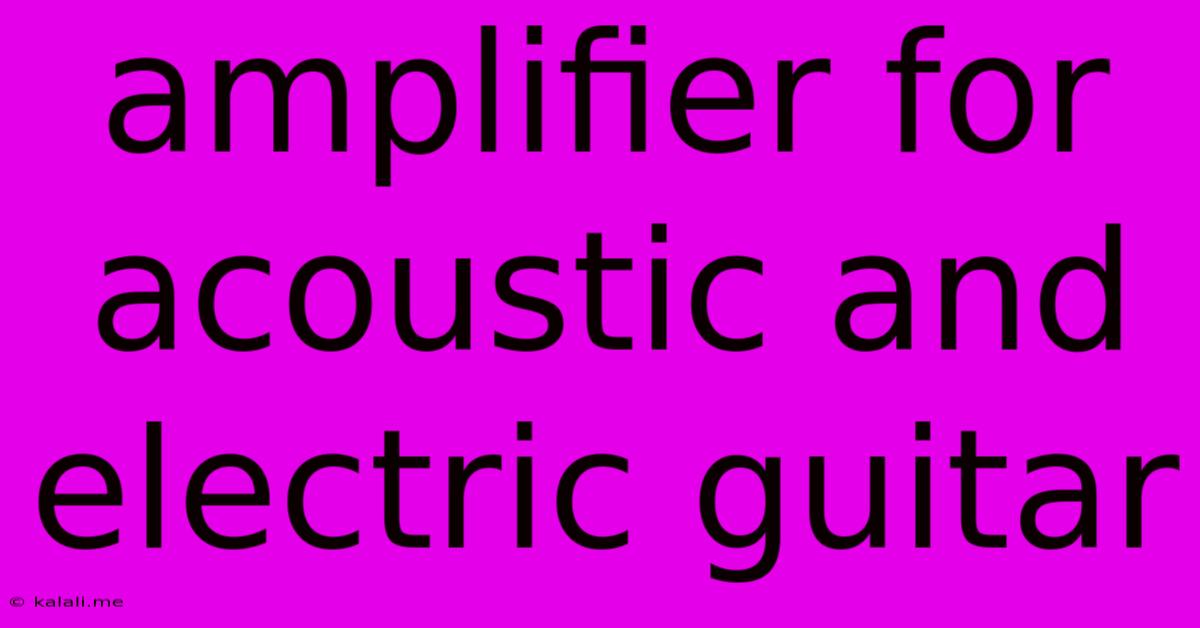Amplifier For Acoustic And Electric Guitar
Kalali
Jun 06, 2025 · 4 min read

Table of Contents
Choosing the Right Amplifier for Your Acoustic and Electric Guitar
Choosing the right amplifier can significantly impact your playing experience, whether you're strumming an acoustic guitar or shredding on an electric one. This guide will help you navigate the world of guitar amplifiers, understanding the key differences and features to consider when purchasing an amp for both acoustic and electric instruments. This article covers essential factors like wattage, speaker size, effects, and versatility to help you find the perfect match for your musical needs.
Understanding Amplifier Types: Acoustic vs. Electric
The fundamental difference lies in how each amp type handles sound. Electric guitar amps are designed to amplify the weak signal from electric pickups, often incorporating features like distortion and overdrive. Acoustic guitar amps are built to accurately reproduce the nuanced tones of acoustic instruments, prioritizing clarity and natural sound reproduction. While some amps cater to both, dedicated amps often provide superior performance for their respective instrument types.
Key Factors to Consider When Choosing an Amplifier
-
Wattage: This dictates the amplifier's volume capacity. Lower wattage amps (e.g., 10-20 watts) are suitable for practice at home or small gigs, while higher wattage amps (e.g., 50 watts and above) are needed for larger venues and louder performances. Consider your typical playing environment.
-
Speaker Size: Speaker size influences the low-end response and overall tone. Larger speakers (e.g., 12 inches) generally produce fuller, richer bass frequencies, while smaller speakers (e.g., 8 inches) are more portable and suitable for brighter, more focused tones. The size you choose depends on your preference and the style of music you play.
-
Channels: Multiple channels provide versatility. Some amps offer separate channels for clean and distorted tones, allowing you to switch between sounds without adjusting knobs mid-performance. This is particularly useful for electric guitar playing.
-
Effects: Integrated effects like reverb, chorus, delay, and EQ are valuable additions, especially in acoustic amps. They add depth and texture to your sound, saving you from needing separate pedals.
-
Inputs: Check the number and type of inputs. You'll need at least one instrument input, but additional inputs for microphones or other devices can be beneficial, particularly for acoustic guitar players who may want to use a microphone for vocals.
-
Versatility: Consider whether you need an amp for both acoustic and electric guitars. Hybrid amps exist but might not offer the optimal sound quality for either instrument compared to dedicated amps. If you play both, you may need two separate amplifiers, or a powerful, versatile amp with multiple channels optimized for different instruments and playing styles.
Acoustic Guitar Amplifiers: What to Look For
Acoustic amps are designed for clarity and natural sound reproduction. Look for features such as:
- High-quality tweeters: These handle high frequencies for a bright and clear sound, crucial for capturing the delicate nuances of acoustic instruments.
- Built-in reverb: Reverb adds ambience and depth, creating a more natural, spacious sound.
- Feedback reduction: Many acoustic amps include feedback reduction technology to prevent unwanted squealing, especially at higher volumes.
Electric Guitar Amplifiers: What to Look For
Electric guitar amps typically focus on distortion, overdrive, and high gain. Key features include:
- Gain control: This allows you to control the level of overdrive and distortion.
- EQ controls: These allow you to shape your tone, adjusting bass, midrange, and treble frequencies.
- Effects loop: This allows you to integrate external effects pedals into your signal chain.
Finding the Right Amp for Both Acoustic and Electric Guitars: The Challenge and Solutions
Using a single amplifier for both acoustic and electric guitars presents challenges. The ideal amp for both will be a compromise, potentially not providing optimal performance for either. Here are some solutions:
- Separate Amps: The best option for serious players. Dedicated amps for each instrument deliver superior sound quality.
- Modeling Amps: These amps use digital technology to emulate various amplifier types and effects. While versatile, they might not perfectly replicate the feel of a tube amp.
- High-Wattage, Multi-Channel Amps: A powerful amp with multiple channels dedicated to different instrument types can be a good compromise, but it may come with a higher price tag.
Choosing the right amplifier is a personal decision, depending on your playing style, budget, and musical preferences. By carefully considering the factors discussed in this guide, you can make an informed decision that elevates your playing experience. Remember to try out different amps if possible before making your final purchase.
Latest Posts
Latest Posts
-
How Do You Test The Spirits
Jun 07, 2025
-
Car Shakes When Stopped At Light
Jun 07, 2025
-
Why Is My Cat Suddenly Attacking Me
Jun 07, 2025
-
Car Battery Charged But Wont Start
Jun 07, 2025
-
Blender Select Bone In Weight Paint
Jun 07, 2025
Related Post
Thank you for visiting our website which covers about Amplifier For Acoustic And Electric Guitar . We hope the information provided has been useful to you. Feel free to contact us if you have any questions or need further assistance. See you next time and don't miss to bookmark.